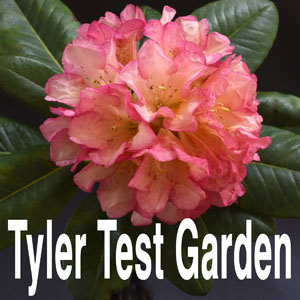
Hybrid Rhododendrons
In the US, rhododendrons are the most impressive flowering shrub in the Northeast and the Northwest, while the most stunning flowering shrub of the Southeast, Gulf Coast and Southern California is the evergreen azalea (neither survive well in the central U.S.). Both are members of the genus Rhododendron, and have very similar blossoms. The basic difference is that azalea flowers have five pollen-bearing stamens while rhododendrons have 10 or more.
Most of the rhododendrons and azaleas grown in gardens are hybrids, and their ability to resist cold differs remarkably from one variety to another. For this reason it is best to purchase rhododendrons and azaleas from a local nurseryman who grows his own plants in open fields. The descriptions below cover rhododendrons that have proved satisfactory in fairly broad regions.
The hybrid rhododendrons are immensely varied in color, size, shape and winter hardiness as a result of their complex genetic background. Generally they are classified as large-leaved, with foliage 3 inches or more in length, and small-leaved, with foliage under 3 inches. The varieties with larger leaves usually have larger flowers, 5 inches or more across, composed of blossoms 2 inches or more in diameter. The individual blossoms of small-leaved types vary from tiny flowers to ones 1 1/2 to 2 inches across, borne in clusters up to 4 inches across.
The cold resistance of a hybrid rhododendron is indicated by a code that indicates the lowest temperature the flower buds can tolerate during the winter and still open perfectly in the spring. Plants bearing the code designation H-1 survive to -25°F, H-2 to -15°F, H-3 to -5°F, H-4 to 5°F, H-5 to 15°F, H-6 to 25°F and H-7 to 32°F. Most varieties grown in the USA range between H-1 and H-4 in hardiness.
The Royal Horticultural Society is the official rhododendron registrar. As of the end of December, 2002, the number of registered rhododendron hybrids was:
- 14,298 hardy rhododendron hybrids suitable for temperate regions
- 12,989 azalea hybrids including both evergreen and deciduous azaleas
- 108 azaleodendron hybrids which are crosses between azaleas and other rhododendrons
- 680 vireya hybrids which are tropical members of the rhododendron family
Of these, several hundred are readily available in the nursery trade and perhaps another hundred are in the greenhouse azalea trade. The most popular plants vary by locale. Deciduous azaleas are popular in both hot and cold climates. Evergreen azaleas are more popular in warm climates and rhododendrons do well in cooler climates. Vireyas only do well in tropical climates or in greenhouses. [Return to Top]
What is a Hybrid Rhododendron
Species are naturally occurring plants that will reproduce
true to their parents from seeds. A hybrid is the product of a
cross with a pollen parent and seed parent which are two different
plants, either species or hybrids or a combination of a hybrid
and a species. This is confusing since there is some variation
within each species. There are also naturally occurring hybrids.
Hybrids all have one trait in common; they will not reproduce
true to the parent from seed.
Hence, R. 'Fabia', the offspring of the species R. dichroanthum ssp. dichroanthum with the species R. griersonianum, is a hybrid. Similarly R. 'Jingle Bell', the offspring of the hybrid R. 'Fabia' with the hybrid R. 'Ole Olson' is also a hybrid. So are crosses of species with hybrids. No two hybrids raised from seed are identical. Also plants raised from seed of a hybrid will not come true to the parent. Some people raise hundreds of seeds from the same two parent plants and get a wide variety of progeny. If it is desired to replicate a hybrid, it must be done vegetatively through cuttings, grafting or tissue culture.
A rhododendron like 'Jingle Bells' is a cultivar that was produced
by crossing two hybrids. It can be perpetuated by vegetative reproduction
only. When written, cultivar names are contained within single
quotation marks and are not italicized. Also, in order to avoid
confusion with species, such names should not be in Latin. Until
the naming rules were standardized in 1958 there were many cultivars
with Latin names; these still stand but new cultivars must have
modern language names.
By following our hybrid example, 'Jingle Bells', back to
its species parents we can learn a lot about its behavior and
characteristics. This is especially important when hybridizing
because it provides valuable clues about the potential results
of crosses.
|
|
-R.dichroanthum |
|
-'Fabia'- |
| |
| | |
|
-R.griersonianum |
'Jingle_
Bells' | |
|
|
| |
|
-R.campylocarpum |
|
_'Ole _
Olson' |
| |
|
|
_R. fortunei
ssp. discolor |
This parentage provides numerous hints about the nature of
the plant. A 'Fabia' background suggests orange flowers (by way
of R. dichroanthum) and narrow pointed leaves (from R.
griersonianum), The other parent, 'Ole Olson', may provide
the touch of yellow (from R, campylocarpum) and may have
led to more rounded foliage (through R. fortunei). But
Halfdan Lem, the hybridizer, also posed interesting questions
with this parentage: how would the large round leaves of R.
fortunei combine with the long narrow leaves of R. griersonianum; and how would the dominant apricot-orange color of R. dichroanthum be affected by the pink R. fortunei?
The end result is a plant that shows little R. fortunei influence, but which clearly states its R. griersonianum background. 'Jingle Bells' is very much an improved 'Fabia', with brighter colors, bigger flower trusses and healthier foliage. So although the influence of the 'Ole Olsen' parentage is not immediately apparent, a look into the background of 'Jingle Bells' soon reveals where the improvements over 'Fabia' came from.
Hybrids are typically between similar plants, for example elepidotes with elepidotes, lepidotes with lepidotes, deciduous azaleas with deciduous azaleas, evergreen azaleas with evergreen azaleas. The closer two rhododendrons are the higher probability they will be able to hybridize. However they can be too close. Some hybrids are self-sterile. In general, rhododendrons in the same subgenus or descended from parents in the same subgenus provide most of the know hybrids. Examples of hybrids whose parents are not from the same subgenus include those between azaleas and rhododendrons, the Azaleodendrons, which are described next. [Return to Top]
The genus Rhododendron is divided into subgenera, with different subgenera for deciduous azaleas, evergreen azaleas, lepidote rhododendrons and elepidote rhododendrons. Most Rhododendron hybrids are between plants in the same subgenus. Azaleodendrons are hybrids between plants in different subgenera. Since few crosses between different subgenera are successful, there are relatively few Azaleodendrons.
When an azalea and a rhododendron are hybridized, the offspring are called azaleodendrons. They are mostly man-made hybrids, but some probably occur naturally in nature. Kenneth Cox observed in his book, Rhododendrons & Azaleas - A Colour Guide, that Azaleodendrons are crosses between elepidote rhododendrons and deciduous azaleas except the Hardijzer's, which are crosses of the lepidote, R. racemosum, with evergreen azaleas. The term Azaleodendron was reserved by scientists for crosses between elepidotes and deciduous azaleas, which were the only known instances of crosses between rhododendrons and azaleas. Hardijzer's crosses were between the lepidote, R. racemosum, and evergreen azaleas. They have been lumped with the Azaleodendrons because there is no other subgenus created for them. Subgenus is classification term that is used for species. Hybrids are not classified with the same terms. However the term nothosubgenus can be use to define a classification similar to subgenus just for hybrids. For more on Azaleodendrons visit the Azaleodendron Page.
|
Rcv. Glory of Littleworth |
Rcv. 'Glory of Littleworth' – was raised by Henry Mangles. It is a stunning plant with fragrant funnel-shaped flowers, opening cream, becoming milky white with conspicuous coppery orange blotch. Flowering in May, this is a superb semi-evergreen azalea-like shrub. It can look a little untidy in the winter, but the flowers are wonderful. Height 5' in 10 years. -5F.
Rcv. 'Hardijzer Beauty' – R. racemosum x (Kurume Azalea) by W. H. Hardijzer, The Nurseries, Boskoop, Holland, before 1958. A dwarf azaleodendron reaching 3' in 10 years, vigorous, upright dense habit. Leaves are retained 2-3 years and may turn purplish-green in winter. Flowers small with strong purplish-pink and lightly flushed deep purplish-pink, purplish-red spotting in throat. –5F, early-mid season. Sun tolerant. It is an excellent choice for a small bed or long, low border.
Rcv. 'Odoratum' – R. ponticum x R. nudiflorum. Glossy, small leaves, evergreen and slightly variegated, numerous trusses of very fragrant blush flowers richly edged with lilac. Late flowering time. Height 4' after 10 years. This old azaleodendron should not be overlooked in today’s gardens. Heat tolerant.
Rcv. 'Ria Hardijzer' – . Lovely small vivid purplish red flowers with faint spots. This is an unusual hybrid between a rhododendron and an evergreen azalea. It is hardy, but dislikes too much heat. Height 2' in 10 years. -5F.
[Return to Top]
R. catawbiense was collected in the wild in 1803 in the Eastern US and was introduced to Britain in 1809. It was hybridized with other rhododendrons introduced cold and heat hardiness in the rhododendron hybrids. The first group of rhododendrons to become popular in gardens was the hybrids called the "iron-clads." There were a group of early British hybrids involving crosses of R. caucasicum, R. catawbiense, R. ponticum and R. maximum that survived the coldest winters at Arnold Arboretum in Boston. In 1917, Ernest Henry Wilson (1876-1930) published a list of what he termed were the "Iron Clad" rhododendrons, meaning those which had been planted in the Arnold Arboretum and were able to survive many winters successfully. This group included:
- Album Elegans, pale purplish pink R. catawbiense hybrid or selection, 6 feet or taller.
- Album Grandiflorum, pinkish white R. catawbiense hybrid or selection, 6 feet or taller.
- Atrosanguineum, bright red with purple markings R. catawbiense hybrid that grows to 4 to 6 feet.
- Caractacus*, magenta R. catawbiense hybrid.
- Catawbiense Album, pinkish white R. catawbiense hybrid or selection, 6 feet or taller.
- Charles Dickens, crimson red with purplish markings R. catawbiense hybrid..
- Everestianum, frilled purplish-pink with green markings R. catawbiense hybrid
- Henrietta Sargent, deep pink R. catawbiense hybrid, 6 feet or taller.
- H. W. Sargent*, crimson R. catawbiense hybrid.
- Lady Armstrong, deep purplish pink with red markings and pale center, R. catawbiense hybrid
- Mrs. Charles S. Sargent, rose pink R. catawbiense hybrid, 6 feet or taller.
- Purpureum Elegans, pinkish purple R. catawbiense hybrid; 4 to 6 feet.
- Purpureum Grandiflorum, violet with green flecks R. catawbiense hybrid; 4 to 6 feet.
- Roseum Elegans, lavender pink with green markings R. catawbiense hybrid, 6 feet or taller.
[Return to Top]
Ten years later he dropped ´H. W. Sargent´ and ´Caractacus´ from this list and merely talked about the "Dozen Iron Clads". Today, this group of a dozen R. catawbiense hybrids is as good as it ever was, even though there must be several thousand evergreen rhododendrons being grown, many of them in the United States. Some have performed well for half a century, others are new and little is known about the limits of their hardiness. Some can be grown only in the South, others in the Pacific Northwest but it is interesting to note that some of the species and varieties have been growing in New England at the Arnold Arboretum since 1891 and the original plants are still alive!
[Return to Top]
Modern Iron-clad Rhododendrons
Iron-clads are by definition plants that have been popular for a long time and are easy to grow, even in cold climates. Some of the original "Wilson's Dozen" plants are no longer easily found and have be replaced by the modern list of "iron-clads":
Modern Iron-Clad Rhododendron
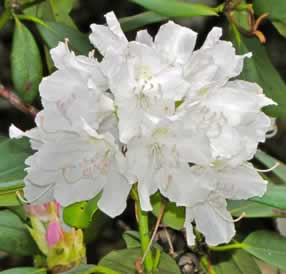 Boule de Neige
Boule de Neige
|
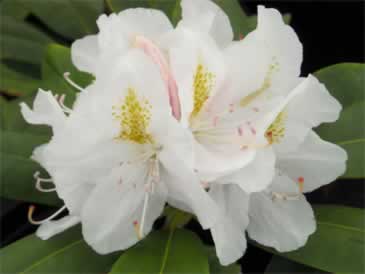 Catawbiense
Catawbiense
Album |
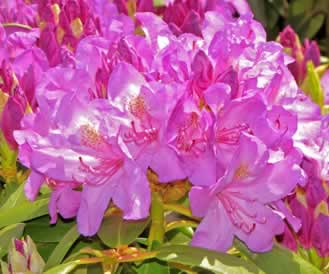 Catawbiense
Catawbiense
Boursalt |
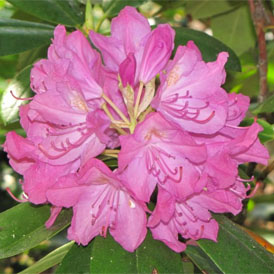 English
English
Roseum |
- *Boule de Neige – 5', -25F. A pure white with green spotting, great leaves (caucasicum x catawbiense hybrid).
- *Catawbiense Album – 6', -25F. A pinkish white R. catawbiense hybrid or selection.
- *Catawbiense Boursalt – 6', -20F. A lilac purple R. catawbiense hybrid or selection.
- *English Roseum – 6', -25F. A soft rose pink, R. catawbiense hybrid.
More Modern Iron-Clad Rhododendron
 Ignatius Sargent
Ignatius Sargent |
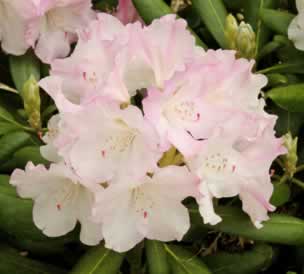 Ken Janeck
Ken Janeck |
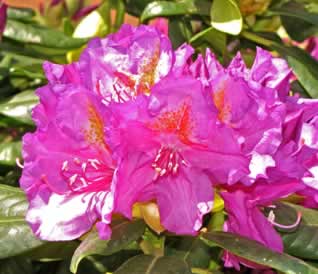 Lee's Dark Purple
Lee's Dark Purple |
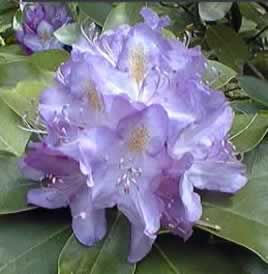 Minnetonka
Minnetonka |
- *Ignatius Sargent – 5', -25F. A deep rose pink R. catawbiense hybrid.
- Ken Janeck – 3', -25F. A pinkish white R. degronianum ssp. yakushimanum hybrid.
- Lee's Dark Purple – 6', -25F. A royal purple with a yellow blotch R. catawbiense hybrid.
- *Minnetonka – 3', -25F. A lavender-pink with a chartreuse blotch R. ponticum hybrid.
More Modern Iron-Clad Rhododendron
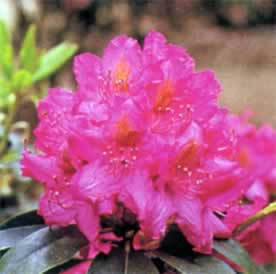 Mrs. Charles S.
Mrs. Charles S.
Sargent |
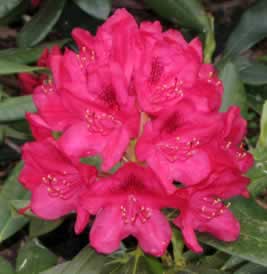 Nova
Nova
Zembla |
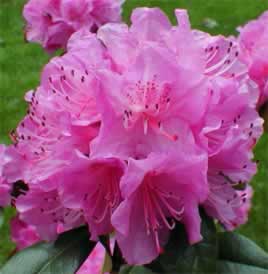 Olga
Olga
Mezitt |
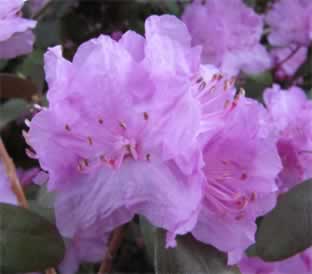 PJM
PJM
|
- *Mrs. Charles S. Sargent – 6', -25F. A rose pink R. catawbiense hybrid.
- *Nova Zembla – 5', -25F. A bright red with black spots, (Parsons Grandiflorum x hardy red hybrid).
- Olga Mezitt – 4', -25F. A deep-pink flowers R. minus; mature leaves are small bronzy green.
- *PJM – 4', -25F. A lavender-pink R. minus; mature leaves are small bronzy green.
More Modern Iron-Clad Rhododendron
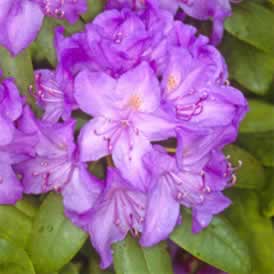 Purpureum
Purpureum
Elegans |
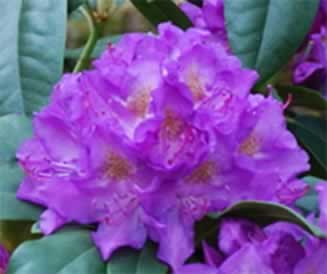 Purpureum
Purpureum
Grandiflorum |
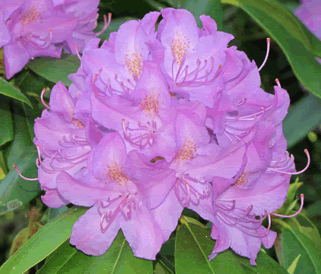 Roseum
Roseum
Elegans |
- *Purpureum Elegans – 6', -25F. A purple with brown spots; R catawbiense hybrid.
- Purpureum Grandiflorum – 5', -25F. A violet with green flecks R. catawbiense hybrid.
- *Roseum Elegans – 6', -25F. A rosy lilac with reddish spotting with orange blotch, R. catawbiense hybrid.
* indicates that it is among the most cold-hardy rhododendrons. [Return to Top]
Best Large Leaf (Elepidote) Rhododendrons
These large-leaved, truss-flowered hybrid rhododendrons are what one usually thinks of when they thing of rhododendrons for landscaping. They range from low to tall with many averaging 4 to 6 feet tall. The height after 10 years and winter hardiness rating are listed for each variety mentioned.
H-1 (USDA Hardiness Zone 4) -25F
Boule de Neige,
Calsap,
Elviira, Henry's Red,
Nova Zembla, Roseum Elegans
H-2 (USDA Hardiness Zone 5) -15F
Anah Kruschke, Ben Moseley,
Catawbiense Boursault, Janet Blair,
Parkers Pink, Red River, Rocket,
Solidarity
H-3 (USDA Hardiness Zone 6) -5F
A. Bedford, Anna Rose Whitney,
Belle Heller, Bow Bells
Jean Marie de Montague,
Moonstone, Purple Splendor
H-4 (USDA Hardiness Zone 7) 5F
Bruce Brechtbill, Grandma's Hat,
Horizon Monarch,
Loderi King George,
Loderi Venus, Mrs. G. W. Leak,
Peter Alan,
President Roosevelt
[Return to Top]
H-1 (USDA Hardiness Zone 4) -25F, Large Leaf (Elepidote) Hybrid Rhododendrons
Standing out in the H-1 group, hardy to Zone 4, with flower buds that tolerate -25°F in winter, are:
Boule de Neige – 5’, -25F. Bright green, leathery leaves on a medium sized, rounded rhododendron. It’s known for its heat and sun tolerance and is extremely cold hardy. Flowers are snow white in ball shaped trusses.
Calsap – 4’, -25F. A very hardy plant with lavender buds that open to white flowers, boldly blotched with burgundy. The smooth, oblong, emerald-green foliage forms a dense cover.
Elviira – 2', -30F. This rhododendron is very hardy. It grows to a height of 2' and width of 18" to 24". It grows well in shade. A very low growing rhododendron cultivar. Densely branched, it is covered with flower buds that are hardy to -30F and open bright red. From the group of Marjatta hybrids developed at the University of Helsinki, Finland.
Henry's Red – 4', -25F. It has a broad, upright habit and bears an abundance of showy, vivid, deep red flowers beginning in mid-April. [return to index]
More H-1 (USDA Hardiness Zone 4) -25F, Large Leaf (Elepidote) Hybrid Rhododendrons
Nova Zembla – 5’, -25F. Here is true hardiness in a red. A vigorous plant that has good foliage and will grow in more difficult areas. This hybrid exhibits some outstanding characteristics. Of course, hardiness tops the list. A nice looking contrast with other plants. Extremely showy, red flowers make a real display in the spring.
Roseum Elegans – 6’, -25F. You can depend on this hybrid in any subzero climate. The rosy lilac flowers are rated down because of their small size, but they are still beautiful. The medium olive green foliage is produced in abundance and does well in hot climates. [return to index]
H-2 (USDA Hardiness Zone 5) -15F, Large Leaf (Elepidote) Hybrid Rhododendrons
Recommended varieties in the H-2 group, hardy to Zone 5, with flower buds that tolerate -15°F in winter, are:
Anah Kruschke – 6', -15F, ML-L. A good looking rhododendron that grows well in sunny, hot locations. Its reddish-purple flowers are held in medium sized, tight trusses. Dense and lush foliage with dark green leaves.
Ben Moseley – 5', -20F. A late midseason blooming Dexter hybrid, its slightly frilled purplish pink flowers with dark spotting in the throat put on a show. It has a nicely branched habit with leaves like 'Scintillation'. It is a popular all-around good grower.
Catawbiense Boursault – 6’, -20F. A hardy selection with rose-lilac blossoms on a plant of good, sturdy habit. It has pleasant, medium-green foliage.
Janet Blair – 5', -20F, M. 'Janet Blair' has large, fragrant, frilled lavender pink flowers fading to a pale center and topped off by a blotch of yellow rays on the upper lobes. The plant, with its glossy green foliage and mounding habit, is not only cold hardy but also heat tolerant. Blooms third week of May, and is better in moderate shade than most other varieties. [return to index]
More H-2 (USDA Hardiness Zone 5) -15F, Large Leaf (Elepidote) Hybrid Rhododendrons
Parkers Pink – 5', -15F. Parkers Pink has large and fragrant flowers of bright deep pink heavily spotted dark red, fading to white in throat. Spectacular 12-flowered trusses, on a tall and well-branched plant, with leaves held for 2 years. One of the best and hardiest of all the Dexters.
Red River – 5', -20F. It is a hybrid of a red flowered maximum. It has the late bloom and the large leaves of maximum. The flowers, larger than maximum's flowers, are bright red with a white throat and small yellow dorsal flare. A robust plant with an upright habit, it can be an open grower, but pinching will help and its habit gets better with age. Good for extending your bloom season into June. 'Red River' is hardy to -20°F. Tolerates sun and shade.
Rocket – 5’, -15F. Luminous, vivid pink. ‘Rocket’s’ thick, heavily veined foliage renders a full bodied appearance to the plant. A fine rhododendron.
Solidarity – 3’, -15F. The medium sized foliage has a coating on the back of each leaf of beautiful wooly indumentum. [return to index]
H-3 (USDA Hardiness Zone 6) -5F, Large Leaf (Elepidote) Hybrid Rhododendrons
Recommended varieties in the H-3 group, hardy to Zone 6, with flower buds that tolerate -5°F in winter, are:
A. Bedford – 6’, -5F. This large growing, vigorous rhododendron tolerates exposure to full sun. Its funnel shaped flowers with ruffled edges are pale mauve to lavender-blue with a distinctive dark blotch. This is a good selection for a background plant.
Anna Rose Whitney – 6’, -5F. Here is a plant which typifies all that is good about rhododendrons. This plant grows quickly to form a very large, densely foliaged, well shaped rhododendron. Deep rose-pink flowers are held in large, open trusses.
Belle Heller – 5’, -10F. Here is hardiness, sun tolerance, lush foliage, and a lovely flower all in one. The large flower is pure white with a striking gold blotch, set in large, ball shaped trusses.
Bow Bells – 3', -5F. It forms a perfect mound of pink. The flowers are followed by shiny, copper colored new leaves. As the season progresses, the mound becomes a superb jade green with rose-red bud scales for another show of color. While growth at 10 years is 3', it will become a larger plant, so give it enough space. A site with filtered light is best for ´Bow Bells´. Fertilize lightly, as an excess of fertilizer will cause foliage burn more easily than on most rhododendrons. [return to index]
More H-3 (USDA Hardiness Zone 6) -5F, Large Leaf (Elepidote) Hybrid Rhododendrons
Jean Marie de Montague – 5’, -5F. Practically every new red introduced must be judged against ‘Jean Marie’ (as it is often called) to see if it is better and few actually pass the grade. ‘Jean Marie’ has bright red flowers so showy that you can’t miss them. The thick, heavy foliage stands sun and is deep emerald-green. Few plants have foliage as green.
Moonstone – 3’, -5F. This plant forms a compact mound covered with oval, smooth green leaves. The flowers are creamy yellow and are borne in profusion. One of the best yellow flowered semidwarfs. [return to list]
Purple Splendour – 5’, -5F. Still the deepest purple, this king of the royal purples has a black throat making it appear even darker. Rich green foliage accentuates this courtly beauty. Plant in an area with good drainage. [return to index]
H-4 (USDA Hardiness Zone 7) +5F, Large Leaf (Elepidote) Hybrid Rhododendrons
Recommended varieties in the H-4 group, hardy to Zone 7, with flower buds that tolerate +5°F in winter, are:
Bruce Brechtbill – 4’, 0F. This hybrid looks and acts identical to ‘Unique’ until it flowers. Then you are graced with blooms that are pink with a touch of yellow in the throat. Since there are few rhododendrons that are sports and ‘Unique’ has about the best foliage around, what could be better than a pink ‘Unique’! Absolutely well worth growing.
Grandma's Hat – 5’, 0F. This plant is somewhat open, grows more tall than wide, and is nicely covered with attractive foliage. The flowers are unusual and very showy, with greenish white centers rimmed with deep purple red, and displaying a darker red blotch.
Horizon Monarch – 6’, 0F. This hybrid is really fantastic. It is the most upright, cone shaped truss of any yellow. Red buds open to a mellow, warm yellow flower with small vivid red flares. Gigantic trusses of 15 or more flowers are very showy. Large, leathery, deep green leaves clothe this lovely plant.
Loderi King George – 6’, 0F. Known as the best white form of the ‘Loderi’ group. The huge flowers open pale pink and then become white. Deliciously fragrant. A magnificent plant that will some day approach the proportions and size of a small tree. Allow plenty of room and give wind and sun protection. [return to index]
More H-4 (USDA Hardiness Zone 7) +5F, Large Leaf (Elepidote) Hybrid Rhododendrons
Loderi Venus – 6’, 0F. Deepest pink of the ‘Loderi’ group and one of the most anticipated. Extremely fragrant. In flower, the sight and fragrance is something you will not soon forget.
Mrs. G. W. Leak – 6’, 0F. Tall, vigorous plant with olive-green leaves. Clear, light pink flowers have a dark blotch in an upright compact truss. Grows in sun or shade.
Peter Alan – 4½’, 0F. An outstanding rhododendron with glossy, deep green foliage that densely covers the vigorous grower. The broad, upright plant has purplish blue flowers accented with a darker eye.
President Roosevelt – 4’, 0F. Showy is the most descriptive word for ‘President Roosevelt’. Both foliage and flower are multicolored. The frilly flower is red, fading to white in the center, and leaves have bold golden streaks along the midrib. A very unusual plant. [return to index]
[Return to Top]
Best Small Leaved (Lepidote) Rhododendrons
The small-leaved, small-flowered hybrid rhododendrons rarely exceed 3 feet in height, and most grow 2 feet tall. They are useful next to foundations, in rock gardens and in front of taller rhododendrons. The height after 10 years and winter hardiness rating are listed for each variety mentioned.
H-1 (USDA Hardiness Zone 4) -25F
April Rose, PJM, Elite, Low Red Frilled,
Regal, Victor, Purple Gem
H-2 (USDA Hardiness Zone 5) -15F
Dora Amateis, Northern Starburst, Pioneer Silvery Pink,
Black Satin, Desmit, Molly Fordham, Olga Mezitt, Ramapo
H-3 (USDA Hardiness Zone 6) -5F
Aunt Martha, Barto Alpine, Blue Diamond,
Pink Magic, Southland. Weston's Pink Diamond
H-4 (USDA Hardiness Zone 7) +5F
Arctic Tern,
Bob's Blue,
Chiffchaff, Chikor,
Senora Meldon,
Snow Lady,
Vibrant Violet, Wren
[Return to Top]
H-1 (USDA Hardiness Zone 4) -25F, Small Leaved (Lepidote) Rhododendrons
Standing out in the H-1 group, which is hardy to Zone 4, with flower buds that tolerate -25°F in winter, are:
April Rose – 3’, -25F. A beautiful pink double flower graces this very hardy rhododendron. It has a slight fragrance and a broadly upright habit. The leaves turn a reddish bronze in autumn, making it very attractive both winter and summer.
PJM – 4’, -25F. This hybrid is cold hardy as well as tolerant of heat and sun. Its small, rounded leaves are green during the summer and mahogany colored in winter. ‘PJM’s’ early bright lavender-pink flowers are beautiful against its dark colored winter foliage. PJM is reported to be the hardiest rhododendron in cultivation. It is cold hardy and tolerant of heat and sun. It has one drawback. Its early bright lavender-pink blooms are so early that sometimes the blooms are killed by an early frost. The glossy green foliage of summer becomes mahogany-colored in winter. It is an excellent landscape plant, will grow under most conditions, and the flowers are long lasting. The flowers are somewhat smaller than most other rhododendrons. There are newer varieties of PJM:
P.J.M. hybrid rhododendrons. Rhododendrons in the 'P.J.M.' group are smaller, growing to a height of 3 to 5 feet tall. Form is rounded and the foliage is leathery and dark green until fall when it turns almost purplish. One of the reasons rhododendrons in the 'P.J.M.' group are such heavy bloomers is that the plants do not set seed. They are very hardy, among the hardiest and most shade tolerant rhododendrons. They include the following:
-
Elite – 4', -25F. It is a vigorous, tall grower and bears an abundance of vivid, showy, rich pink flowers in mid-April.
-
Low Red Frilled 4', -25F. It has a spreading, short, compact habit and bears an abundance of showy, frilled, vivid red flowers beginning in mid-April. [ Return to List]
More H-1 (USDA Hardiness Zone 4) -25F, Small Leaved (Lepidote) Rhododendrons
More P.J. M hybrid rhododendrons
-
Regal – 5', -30F. It is a vigorous grower with a broad, spreading habit which bears an abundance of showy, vivid, light purplish-pink flowers beginning in mid-April.
-
Victor – 4', -25F. It is a slow grower with a compact habit and bears an abundance of showy, vivid, light purplish-pink flowers in early April.
Purple Gem – 2’, -25F. Similar to the popular ‘Ramapo’, this plant has leaves that are slightly more rust colored and flowers which are deeper purple-violet. New foliage emerges with beautiful blue tones. [Return to List]
H-2 (USDA Hardiness Zone 5) -15F, Small Leaved (Lepidote) Rhododendrons
Recommnended varieties i the H-2 category, hardy to Zone 5, with flower buds that tolerate -15°F in winter, are:
Dora Amateis – 3’, -15F. Pure white flowers cling to this low growing, bushy plant which has become a favorite of many people. Its deep green, dense foliage is highlighted with bronze tones and is prettiest when grown in full sun. This spicy scented hybrid is being planted as a low border and as a small mass planting to bring attention to its pretty foliage.
Northern Starburst – 4’, -20F. Similar to PJM, but a much stronger-growing plant, with larger and heavier blooms, stems and foliage. This is a four-season performer, beckoning to spring with fat reddish buds bursting into bright pink blooms, followed by new foliage of bright apple green. In fall, foliage changes from green to cinnamon then to deep purple as winter approaches. As a plus, it’s very hardy!
Pioneer Silvery Pink – 4’, -20F. This is the proper name of the plant that came from Fruit Valley as Silvery Pink. Long, lustrous, dark green leaves beautifully frame the shiny, clear pink flowers. It is a wide, upright growing and vigorous plant. Very elegant[return to list]
Ramapo – 2’, -20F. Plentiful pale violet flowers dance amid this bushy blue-green mat of leaves. It has pleasing foliage color changes throughout the year, especially favored are the dusty blue new leaves following a shot of growth. This hardy dwarf can be grown in sun or partial shade, although in full sun it will maintain a more compact form. It is well suited for use in a low border or rock garden. [Return to List]
More H-2 (USDA Hardiness Zone 5) -15F, Small Leaved (Lepidote) Rhododendrons
Standing out in the H-1 group, which is hardy to Zone 4, with flower buds that tolerate -25°F in winter, are:
P.J.M. hybrid rhododendrons. Rhododendrons in the 'P.J.M.' group are smaller, growing to a height of 3 to 5 feet tall. Form is rounded and the foliage is leathery and dark green until fall when it turns almost purplish. One of the reasons rhododendrons in the 'P.J.M.' group are such heavy bloomers is that the plants do not set seed. They are very hardy, among the hardiest and most shade tolerant rhododendrons. They include the following:
- Black Satin – 3', -20F. It has a semi-erect habit and bears an abundance of showy, vivid, dark rose-pink flowers in mid-April. Fall and winter foliage is glossy and very dark purplish-black.
- Desmit – 1', -20F. It has a dense, mounding habit and bears an abundance of vivid, showy, pink flowers in early April. This cultivar has shown to be moderately resistant to sun scalding.
- Molly Fordham – 4', -20F. It has a compact habit and bears an abundance of showy, vivid, white flowers beginning in early May.
- Olga Mezitt – 3', -15F. It is a vigorous grower with a spreading, upright habit and bears an abundance of showy, vivid, peach-pink flowers beginning in late April. [Return to List]
[return to list]
H-3 (USDA Hardiness Zone 6) -5F, Small Leaved (Lepidote) Rhododendrons
Choice H-3 varieties, hardy to Zone 6, with flower buds that tolerate -5°F in winter, are:
Aunt Martha – 5', -10F, M-ML. Hardy, vigorous, densely foliated and heavy blooming plant. Plenty of leathery leaves enable the plant to grow well in full sun and moderate heat. Bright red-purple flowers are speckled with gold in the center.
Barto Alpine – 3', -10F, EM. Orchid-rose flowers open all along the stems of the densely branched plant. It has the spicy scent of freshly ground nutmeg. Its dense upright growth habit is a form well-suited for planting as a short hedge or screen reaching 5'.
Blue Diamond – 3’, -5F. A favorite of many gardeners, ‘Blue Diamond’ has small flowers all along the vertical dense, finely branched stems. A sunny location is best for this well shaped plant often used as a border.
More H-3 (USDA Hardiness Zone 6) -5F, Small Leaved (Lepidote) Rhododendrons
Pink Magic – 4-5', -10F. A lepidote with glossy apple green foliage and large pink, somewhat bell-shaped early flowers. This is almost the same cross as the popular white hybrid 'Dora Amateis', but this is pink rather than white and is a heat tolerant, dependable grower. It can burn in northern, colder winters, but it always recovers.
Southland – 2', -10F. A truly fine lepidote, 'Southland' has many good features. From chapmanii, it inherited heat and sun tolerance and from keiskei, cold hardiness and an interesting color. It is a semi-dwarf plant that forms a low dense mound of glossy medium green leaves slightly larger than its keiskei parent. 'Southland' is very floriferous with peachy to creamy pink flowers, a color that is a bit hard to describe, but very pleasing. All of these benefits coupled with hybrid vigor make 'Southland' a highly desirable early May blooming lepidote.
Weston's Pink Diamond – 5', -10F. It is a semi-evergreen shrub with a spreading, upright habit and bears an abundance of frilled, double, vivid, pink flowers in early April. [return to list]
H-4 (USDA Hardiness Zone 7) +5F Small Leaved (Lepidote) Rhododendrons
Recommended varieties in the H-4 group, hardy to Zone 7, with flower buds that tolerate +5°F in winter, are:
Arctic Tern – 2’, 0F. Talk about electric blue! This is it! Introduced by Bob Rhodes from Vancouver, British Columbia, this is a good addition to the world of blue rhododendrons. It is a lepidote type rhododendron and has small, deep green leaves that turn bronze in the winter. Flowering extremely well. 6-10"
Bob's Blue – 3’, 0F. A rhododendron with a very tight ball truss of up to 20 frilled white flowers in perfect miniature. A great little plant that should have its `tern’ in your garden.
Chiffchaff – 2’, 5F. A compact little plant with small, loose trusses of bright, lemon yellow flowers. The fuzzy dark green foliage turns a lovely shade of bronze in the winter, adding to the enjoyment of this great little rhododendron. [return to list]
Chikor – 18", 0F. A fine, true yellow dwarf rhododendron from Peter Cox. The intricate, twiggy stems make this plant appear like a tree in miniature. Winter weather brings a bronze-red coloration to the foliage that contrasts well with accompanying winter greens. A well drained location and good light exposure are a must.
More
H-4 (USDA Hardiness Zone 7) +5F Small Leaved (Lepidote) Rhododendrons
Senora Meldon – 4’, 0F. This is the best of the R. augustinii type hybrids. It has wisteria blue flowers which are very abundant on a plant that has the best foliage of its type. The leaves in summer are lustrous green and in winter become a light bronze. A good looking plant all year, but in spring when it covers itself with blue there are few plants that can match its beauty. It is upright growing, yet compact, a plant that you can’t help but enjoy wherever you plant it.
Snow Lady – 30", 0F. An aptly named plant reminiscent of newly fallen snow. Soft fuzzy green leaves enhance the pale petal color dressing it up like a real ‘lady’. Flowers well in deep shade. Much appreciated because it buds easily and blooms early.
Vibrant Violet – 3’, 0F. The name says it all. Small, pointed dark green leaves are a beautiful backdrop for these very bright violet flowers on a plant that tends to stay small. [return to list]
Wren – 1’, 0F. Shiny green leaves grace this delightful little flat growing, but mound forming plant. When spring arrives, it covers itself with bright sunny yellow flowers that would bring warmth to any garden. [return to list]
[Return to Top]
Hybrid Naming Conventions
If you understand the basic ideas of genus,
subgenus, section and species you will have a better understanding of rhododendron naming conventions. A rhododendron species can be uniquely identified with the genus and species. Hence Rhododendron albiflorum defines a unique species. There may be another genus that uses the name albiflorum since it is Latin for "white flowering".
Species are naturally occurring plants that will reproduce
true to their parents from seeds. A hybrid is the product of a
cross with a pollen parent and seed parent which are two different
plants, either species or hybrids or a combination of a hybrid
and a species. This is confusing since there is some variation
within each species. There are also naturally occurring hybrids.
Hybrids all have one trait in common; they will not reproduce
true to the parent from seed.
Hybrids are called varieties and identified by cultivar, hybrid
and clone.
All garden plants are commonly called varieties, but the botanical
definition is more precise.
When a species is selected from the wild and cultivated it is called a variety. Such a variety is a naturally occurring variation of a species, expressed as the abbreviation var., as in Rhododendron forrestii var. tumescens. When cultivated it may also be known as a selected form.
Cultivar or cultivated variety refers to plants, occurring
either naturally or in cultivation, that are not capable of reproducing
true to the original plant naturally and which must be perpetuated
by vegetative propagation.
Clones are vegetative replicas of the original cultivar or
hybrid.
A rhododendron like 'Jingle Bells' is a cultivar that was produced
by crossing two hybrids. It can be perpetuated by vegetative reproduction
only. When written, cultivar names are contained within single
quotation marks and are not italicized. Also, in order to avoid
confusion with species, such names should not be in Latin. Until
the naming rules were standardized in 1958 there were many cultivars
with Latin names; these still stand but new cultivars must have
modern language names.
By following our cultivar example, 'Jingle Bells', back to
its species parents we can learn a lot about its behavior and
characteristics. This is especially important when hybridizing
because it provides valuable clues about the potential results
of crosses.
|
|
-R.dichroanthum |
|
-'Fabia'- |
| |
| | |
|
-R.griersonianum |
'Jingle_
Bells' | |
|
|
| |
|
-R.campylocarpum |
|
_'Ole _
Olson' |
| |
|
|
_R. fortunei
ssp. discolor |
This parentage provides numerous hints about the nature of
the plant. A 'Fabia' background suggests orange flowers (by way
of R. dichroanthum) and narrow pointed leaves (from R.
griersonianum), The other parent, 'Ole Olson', may provide
the touch of yellow (from R, campylocarpum) and may have
led to more rounded foliage (through R. fortunei). But
Halfdan Lem, the hybridizer, also posed interesting questions
with this parentage: how would the large round leaves of R.
fortunei combine with the long narrow leaves of R. griersonianum; and how would the dominant apricot-orange color of R. dichroanthum be affected by the pink R. fortunei?
The end result is a plant that shows little R. fortunei influence, but which clearly states its R. griersonianum background. 'Jingle Bells' is very much an improved 'Fabia', with brighter colors, bigger flower trusses and healthier foliage. So although the influence of the 'Ole Olsen' parentage is not immediately apparent, a look into the background of 'Jingle Bells' soon reveals where the improvements over 'Fabia' came from.
[Return to Top]
Registration of Hybrid Names by Jay Murray
Formal registration of names for cultivated plants is now practiced internationally, but until fairly recently selection of names was rather haphazard. Names were applied to plants without considering whether they were already in use for another plant in the same genus. The name 'Sunset', for example, was given to at least nine different cultivars in genus Rhododendron, while 'Pink Delight' was used for at least seven. When such duplication occurs, the name does not serve its primary purpose, which is to identify each particular plant uniquely.
According to David Leach (Rhododendrons of the World, 1961), the first rhododendron species was introduced to Britain in 1656 (R. hirsutum from the European Alps). By 1800 only 12 species were known in cultivation (including R. canescens, R. periclymenoides, R. viscosum, R. catawbiense and R. maximum from North America, and R. ferrugineum and R. ponticum from Europe). The first known deliberate hybridizing of elepidotes occurred in 1810 when Michael Waterer crossed R. maximum with R. catawbiense. That is the time when name registration should have begun.
It was not until the early 1950s, however, that the first international effort was made to stabilize horticultural plant names. It soon expanded to include all cultivated plants. Presently, International Registration Authorities (IRAs) operate under regulations and recommendations formulated by representatives of agricultural, forestry, and horticultural products, under the auspices of the International Commission for the Nomenclature of Cultivated Plants. This body operates under authorization of the International Union of Biological Sciences which itself serves under the Inter national Council of Scientific Unions operating under the United Nations Educational, Scientific and Cultural Organizations (UNESCO).
In 1955 the Royal Horticultural Society (RHS) was asked to serve as the International Registration Authority (IRA) for the genus Rhododendron. Dr. H.R. Fletcher of the Royal Botanic Garden, Edinburgh, was the first international registrar for the genus. His initial duties were to compile and publish a list of all cultivated varieties of rhododendron and azalea names known up to that time. Source materials included catalogs, books, magazines, publications of plant societies, and lists submitted by growers. The American Rhododendron Society (ARS) was able to contribute substantially to this effort because one of the early objectives of the Society was to stabilize the naming of American rhododendron hybrids. As early as 1949, the ARS was formulating rules of nomenclature and seeking cooperation from growers.
The initial compilation of names, titled The International Register of Rhododendron Names was published by the RHS in 1958. Now out-of-print, it is 290 pages long and contains over 6000 names. The acknowledgements recognize the contributions of Dr. J. Harold Clarke, Dr. Henry Skinner, Dr. John Wister, Frederick P. Lee, and Mrs. Ruth Hansen, then secretary of the American Rhododendron Society. J. Harold Clarke had been appointed chairman of the ARS Nomenclature Committee in 1949. After proposing guidelines for naming clones, he issued the first of many appeals to breeders to submit names for screening before actually using them. The American Rhododendron Society appointed Dr. Clarke the first ARS registrar in 1955. Although proceeding independently, the ARS cooperated with the RHS by submitting names for approval, forwarding all data, and even sending a contribution of $25 in 1968 to help defray registration costs. In 1969, Jock Brydon was appointed ARS registrar. The following year the ARS Board of Directors voted to discontinue acting as registrar in North America because too many members were submitting applications directly to the RHS. This defection may have occurred because the ARS attempted to include plant evaluation in the name registration process. Actually, there has never been a requirement for official trials of plant quality prior to name registration. Evaluation is a function that should be performed by the grower before conferring a name upon the cultivar. In 1971 when the ARS apparently decided to comply with the regulations of the Cultivated Code, Edwin Parker was appointed ARS Registrar and served with distinction until his retirement in 1985. Since that time I have served in the capacity of North American registrar, reporting directly to Dr. Alan C. Leslie, International Rhododendron Registrar and Senior Registrar for the RHS. Current nomenclature regulations and recommendations are published in the International Code for Nomenclature of Cultivated Plants -- 1995. By definition, the full name of a cultivar is the botanical name (in Latin) of the appropriate taxonomic group followed by the cultivar epithet (e.g., Rhododendron 'Mars' or R. yakushimanum 'Koichiro Wada'). Present rules for naming are quite liberal. The major consideration is that the cultivar epithet must consist of no more than 10 syllables and no more than 30 letters or characters overall, excluding spaces. Names that might lead to confusion will be rejected. Preliminary screening may be accomplished by calling (732)-946-8627 or e-mailing arsreg@yahoo.com at any time. Final approval is given by the International Registration Authorities.
The registration application is divided into sections relating to: (1) parentage of the plant; (2) people associated with its hybridizing, growth, naming, commercial introduction, and registration; and (3) description of flowers, leaves, and growth characteristics. The form is accompanied by instructions illustrating typical flower, truss, and leaf shapes. Much of the descriptive material may be reported simply by checking appropriate boxes. Flower color is an important characteristic best described by reference to a color chart, preferably one of the editions of the RHS Colour Chart, but a name will not be rejected if the color is described in words rather than by reference to color numbers. All reasonable assistance will be given to those submitting applications. For example, presence of indumentum (either scales or woolly, plastered, or glandular hairs) is an important characteristic that may be difficult to describe. Upon request, the registrar will prepare this portion of the application if a typical leaf is enclosed. Remember that those who name plants have a responsibility to other growers as well as to the public to provide a permanent record for purposes of identification. Names and descriptions of all newly registered North American rhododendrons and azaleas are published quarterly by the ARS. The RHS publishes all additions to the Rhododendron Register annually. North Americans may request registration applications from me (phone and e-mail address given above). Others should write to the International Rhododendron Registrar, The Royal Horticultural Society's Garden, Wisley, Woking, Surrey GU23 6QB, England.
[The current issue of the International Code of Nomenclature for Cultivated Plants is the Eighth Edition, 2009.]
[originally printed in the September 1999 issue of the Rhododendron and Azalea News] This was written for "Rhododendron and Azalea News" by Jay Murray, the North American Rhododendron Registrar.. Jay did a tremendous amount of work as the Registrar. She was honored by the American Rhododendron Society with the ARS Gold Medal, the Society's highest award. She is a member of the Princeton Chapter. The current registrar is Michael Martin Mills.
To actually register a Rhododendron or Azalea name go to the ARS Website.
[Return to Top]
How To Grow Hybrid Rhododendrons
All rhododendrons and azaleas will grow well in light shade; the Carolina rhododendrons will bloom more abundantly in full sun if the soil is kept moist, but in hot climates or in windy places shade is usually mandatory. Balled-and-burlapped plants may be transplanted in blossom but it is better to transplant them early in spring in areas where their hardiness is questionable, and in spring or fall where there is no likelihood of winter damage.
The most important factor in achieving vigorous growth is an acid soil mixture high in organic content. Many commercial growers set rhododendrons and azaleas in pure peat moss, or in a 50-50 mixture of peat moss and coarse sand or perlite. A favorite mixture on the West Coast is 1/2 peat moss and 1/2 ground redwood, but in such mixtures, plants must be fed regularly.
Because the roots grow near the surface, a bed prepared especially for rhododendrons and azaleas need not be more than 12 inches deep; deep planting keeps the roots from getting the air they need. In fact, it is a good idea to set them about 1 inch higher than they grew at the nursery.
Cultivating the soil around rhododendrons and azaleas would damage their roots. Instead, keep the roots cool and moist with a permanent 2- to 3-inch mulch of wood chips, oak leaves, chunky peat moss or other light organic material. Plants that have been given a soil mixture rich in organic matter probably will not need feeding for several years. Do not stimulate fast growth because it produces long weak stems and few flowers. But if a plant seems weak or sickly, use cottonseed meal or a special rhododendron-azalea-camellia fertilizer, dusted on the soil early in the spring. For maximum flower production, pinch off faded flowers or the seed capsules that follow.
[Return to Top]
Directory of Contents for Henning's Rhododendron & Azalea Pages
•• Providing Information about the Genus Rhododendron since 1996
••
Articles Published by the American Rhododendron Society
Return to Top

Last Updated:
July 6, 2020
|